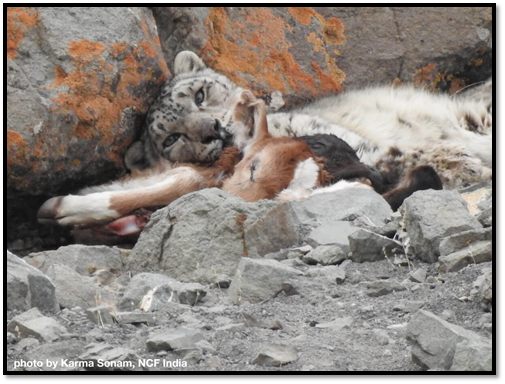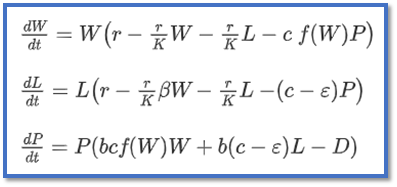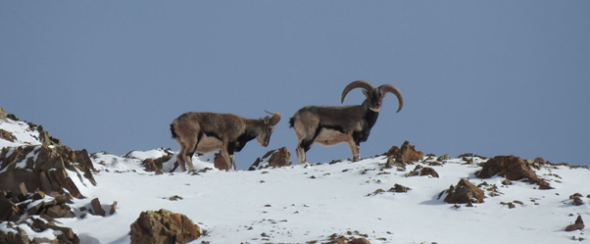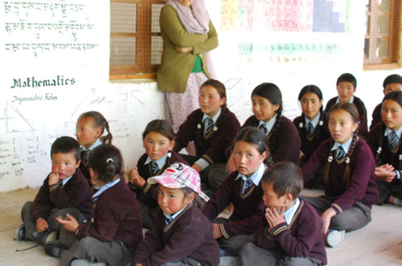Ecological Theory for Conservation
Posted: April 13, 2019 Filed under: 2019, BIOL420, conservation, ecology, ERES525, Module Critique Assignment Leave a commentby Abhijeetkumar
Abstract
In this work, I propose the use of the Prey Refuge Model as an applicable ecological theory for conservation to reduce predator-human conflict.
For the purpose of this article, I am explaining the Prey Refuge Model and considering two important questions:
- Can species coexistence occur without livestock losses?
- Can the equilibrium be stable or not?
A numerical illustration of the model is provided to support the analytical and theoretical findings that suggest the Prey Refuge Model can be applied to create coexistence between the 3 species, predator, livestock and prey with reduced human-predator conflict.
This article also proposes the utilisation of planned refuges for prey and novel methods like insurance to minimise livestock losses to herders as a means to reduce retaliatory killing and decrease human-predator conflict with the example of Project Snow Leopard.
Lastly the article also questions the research-practice gap of implementing the model and human willingness to work towards win-win ecology.
Introduction
Historically, human carnivore conflict has been a long standing challenge. In terms of a solution, one angle to consider would be the perception, values and beliefs of natives, the laws of the land; while another would be their economic conditions. Rather than a one pronged solution, inter-disciplinary approaches may help address conflicts better (Pooley et al., 2017; Redpath et al., 2017).
While the world may look at the loss of livestock as a mere loss of a few cows and sheep, to poor rural natives, it is often their only wealth and source of livelihood. Often, the carnivore may eat only one animal, but the resulting attack causes injury to several livestock thus smashing the humble dreams of their herders.
The resentment at the loss of livestock is deep rooted and often the cause of most human-carnivore conflicts leading to the death of endangered carnivores that conservationists seek to save.

For herders in snow leopard habitat, losing even one animal can be devastating.
Photo: Karma Sonam, NCF India.
In my mind, a sensible and realistic solution to the human-carnivore conflict mostly revolves around the problem of the coexistence between the predator, its natural prey, and livestock. To protect endangered carnivores, we must protect livestock and for that, availability of wild prey is critical.

Specifically, I will present how the Prey Refuge Model can influence conservation interventions and discuss its outcomes with examples of ‘Project Snow Leopard’ in India.
It is often lamented that conservation policies remain uninformed by ecological theory and are heavily dependent on expert opinions and experiential decisions (Doak and Mills, 1994; Driscoll and Lindenmayer, 2012; Ryall and Fahrig, 2006).
For example, a well-meaning decision to connect fragmented habitats through corridors can hasten extinction due to destabilizing effects of dispersal (Earn et al., 2000), and progress stalls under the strain of such conflicting results.
Additionally, most ecological models give solutions to practical problems. For example, the history of classical prey-predator models (Volterra, 1926), can be traced to a need for fisheries management (Kingsland, 1995).
Thus, I believe that ecological theory and models should be utilised as they are pertinent to conservation practices and I will illustrate this in conclusion with the example of Project Snow Leopard in India.
Prey Refuge Model (Sih, 1987; Vance, 1978)
Prey-predator interactions reflecting human-carnivore conflict can be captured by models that consider refuges for prey (Sih, 1987; Vance, 1978). Here, the 2 species of prey differ in their degree of susceptibility to a predator; this makes them a suitable template for understanding systems with livestock, wild prey and carnivores.
The basic model for density of each of the species is of the following form (Sumanta B, 2018):

Where:
| W = | Wild prey |
| L = | Livestock |
| P = | Predator |
| r = | Maximum per capita growth of wild prey |
| K = | Carrying capacity of the habitat |
| c = | Capture rate of prey by predator |
| β = | Competitive advantage of one prey over another |
| ε = | Predator avoidance advantage of livestock through husbandry |
| b = | Conversion deficiency of predator |
| D = | Density independent mortality through metabolic demands of the predator |
Predation on wild prey follows a functional response f(W) depending the availability of Refuges. In this model the prey can grow to its maximum in the absence of its competitor or predator.
The wild prey and livestock are sufficiently similar in their life history traits (e.g., body size, birth rate, resource consumption rates, etc.) so that their r and K are not modelled separately, but by common terms.
Search rate of the predator is c, and it can capture wild prey at the rate cf(W)W.
The predator’s functional response f(W) describes how capture rate varies with prey density. If all wild prey are protected, and hidden in refuges (R), then f(W) = 0. Any surplus wild prey which are not protected in refuges, W − R, are susceptible to predation.
Effectively, the predator can catch only a fraction of the wild prey population. This is a reasonable approximation for many natural systems. For example, in the Himalayas; ibex (Capra sibirica) stay in proximity of steep cliffs in order to avoid attacks by snow leopards; they are more vulnerable when foraging away from cliffs (Fox et al., 1992). Similarly, the predator searches the habitat and captures livestock at the rate (c − ε)L instead of cL, as ε represents the predator avoidance among livestock, since some encounters (ε) get thwarted by vigilant herders and guard dogs, etc.
The two prey compete with each other; the net competitive effect of one prey over the other is β. The predator converts prey (food) into offspring with a conversion efficiency b.
Net foraging return on wild prey can be bcf(W)W = bc(W − R), and on livestock it is b(c − ε)L. In absence of any prey, the predator population declines due to starvation at the rate – DP.
This model has two stabilizing elements: the habitat’s carrying capacity K, which keeps the prey becoming too abundant, and refuges R, which prevent prey from becoming too rare. One should expect stable coexistence of all three species (Vance, 1978).
It gives rise to two important questions:
- Can species coexistence occur without livestock losses?
- Can the equilibrium be stable or not?
The first important question is whether all 3-species coexistence can occur without livestock losses.
Conservation interventions would aim to establish conditions where L is immune to attacks, or, c = ε. This is often attempted via increased vigilance while herding, strengthening of corrals, and guard dogs (Gehring et al., 2010). If successful, then an equilibrium can be achieved.
At this equilibrium, all three species can have positive densities. Interestingly, at the Himalayas it is observed that the snow leopards depend on wild prey, and not on livestock. (Suryawanshi et al., 2017). High livestock populations can be maintained when competitive interactions are weak. But, high predator density exists when competition is weak. So, meaningful densities of all species can exist only within a narrow range of competitive interactions that satisfy these opposing demands which is more likely to be met in high-productivity ecosystems.
The next important question is whether this equilibrium is stable, or not.
Conservation efforts that result in increased predator populations can intensify conflicts (Rigg et al., 2011). Models are judged stable when a small disturbance occurs and they become unstable if the disturbance grows. It is known (Vance, 1978), that these solutions are stable only when carrying capacity for the habitat is high and the Refuge is greater than Dbc.
The key insight from model solutions is that three-species stable coexistence depends on the size of refuges. High predator and wild-prey density can be achieved only under plentiful refuges; which necessarily also lead to low density of livestock (because carrying capacity is split between the two types). Consistent with the coexistence conditions, these stability conditions are also likely to be met in high-productive habitats.
Conservation implications:
In this model, humans can intervene to alter prey-predator encounters. But, for simplicity, livestock and wild prey are considered to be sufficiently similar in their life-history traits (e.g., sheep/bharal in Himalayas).
It contains a number of parameters that are ecologically meaningful. But, these parameters, or traits (R, D, b and c), may be difficult to manipulate in free-ranging animals in order to meet the coexistence and/or stability criteria.
Perhaps, forage competition (β) can be manipulated, and competitive effects of livestock on wild prey can be reduced via measures such as stall-feeding. But this can inflate their populations, and have indirect effects on carrying capacity.
Protecting livestock alone can enable coexistence; the model also prescribes reducing livestock density which will likely compromise human livelihoods, thus undermining the constituency for conservation (Harihar et al., 2015; Redpath et al., 2013).
In summary, conflict-free scenarios are possible in the prey-refuge model. But, the common practice of protecting livestock in conflict situations may actually be detrimental for predator’s survival, unless the carrying capacity of the habitat is high enough to accommodate refuges for the wild prey. This approach to reducing conflict may lead to favourable outcomes in productive habitats (high K). It is less likely to succeed in less productive ones (low K), because it is difficult to manipulate the parameter space determined by β, R, D, b and c.

The availability of wild prey is key for the predators’ survival. Photo: NCF India.
When a habitat is naturally very productive, it may be possible to prevent all attacks on livestock, have sufficient refuges for wild prey, and have meaningful density of the predator.
However, this model offers strong justification to strive for at least some areas that are inviolate of human use as parks and reserves.
Conclusion
The results of the model about prey-predator interactions demonstrate implications of ecological theory for guiding conservation practice.
The Prey-Refuge Model was evaluated against equilibrium densities, and the stability of the equilibrium. For example, increase in wild prey abundance can coincide with strengthening of conflict with predators (Stahl et al., 2002; Suryawanshi et al., 2017).
This model also shows that reducing livestock-loss is more likely in habitats that are already highly productive, compared to unproductive ones. Conditions for coexistence and stability are more likely to be simultaneously satisfied in productive habitats.
The final, and crucial, step is to assess research to practice gaps and whether the models strategies are implementable. In the absence of quantitative tests of these models, one can use qualitative guidelines. Analysing and creating proper refuges for both the wild preys and livestock’s will help in increasing densities of all three species. Better refuge management studies can offer insights into the ideal as well as sufficient conditions for conflict-free coexistence between livestock, wild prey, and predators.
So, Prey-Refuge model stands as a perfect model for the coexistence of all three species and thus considerably reducing predator-human conflict.
An example of this is Project Snow Leopard in India.
Project Snow Leopard launched in January 2009 aims to conserve biodiversity with community participation. It aims to promote a knowledge-based and adaptive conservation framework that fully involves the local communities, who share the snow leopard’s range, in conservation efforts. (Project Snow Leopard – Ministry of Environment & Forests).

We’re trying to inspire the next generation of conservation champions through education programs. Photo: Snow Leopard Trust
In the Indian Himalayas, livestock outnumber wild prey and the snow leopard is heavily dependent on livestock. From the late 1990s and early 2000s, conservation interventions created livestock-free patches (strategically identified valleys, and watersheds in the mountainous landscape) which were expected to help recovery of the wild prey and reduce impact of snow leopard on livestock (Mishra et al., 2010). This essentially creates designated patches for the wild prey and livestock but drastically hampers the livelihood of the pastoralist and ranchers. Specially the most affected are the small-scale individual cattle farmers to whom shifting the farm must have incurred losses.
One of the solutions to this human-wildlife conflict is covering the open roofs of livestock pens with wire-mesh. “Sometimes it’s really easy to find a way for humans and wildlife to coexist,” (The Week 2016).

Simple solutions for complex problems – A wire mesh roof for pens
Photo Credit – NCF India
Another simple solution is livestock insurance. Unique livestock insurance schemes enhance prospects for herders and carnivores and have significantly reduced retaliatory killing.
While the success of this project is something that conversations can emulate, it brings us back to the dilemma of human willingness. Is the world ready for win-win ecology, are we ready to coexist with the wild, understand the ecosystem and work together or should we still only focus on reserving wildlife zones which build resentment towards conservation for locals and landowners who get the losing side of the stick?
References:
R.R. Vance, Predation and resource partitioning in one predator – two prey model communities, Am. Nat., 112 (1978), pp. 797-813 Google Scholar
Volterra, Fluctuations in the abundance of a species considered mathematicallyNature, 118 (1926), pp. 558-560 Google Scholar
Wang, B. Haegeman, M. Loreau, Dispersal and metapopulation stability, PeerJ, 3 (2015), Article e1295 Google Scholar
D.J. Earn, S.A. Levin, P. Rohani, Coherence and conservationScience, 290 (2000), pp. 1360-1364 Google Scholar
K.R. Suryawanshi, S.M. Redpath, Y.V. Bhatnagar, U. Ramakrishnan, V.Chaturvedi, S.C. Smout, C. Mishra, Impact of wild prey availability on livestock predation by snow leopardsR. Soc. Open Sci., 4 (2017), Article 170026, 10.1098/rsos.170026Google Scholar
Simberloff, The contribution of population and community biology to conservation scienceAnnu. Rev. Ecol. Syst., 5 (1988), pp. 473-511 Google Scholar
S.E. Kingsland, Modeling Nature: Episodes in the History of Population EcologyUniversity of Chicago Press, Chicago (1995)Google Scholar
Harihar, D. Veríssimo, D.C. MacMillan, Beyond compensation: integrating local communities’ livelihood choices in large carnivore conservationGlob. Environ. Chang., 33 (2015), pp. 122-130, 10.1016/j.gloenvcha.2015.05.004Google ScholarEklund, J.V. López-Bao, M. Tourani, G. Chapron, J. Frank, Limited evidence on the effectiveness of interventions to reduce livestock predation by large carnivoresSci. Rep., 7 (2017), Article 2097, 10.1038/s41598-017-02323-wGoogle Scholar
D.A. Driscoll, D.B. Lindenmayer, Framework to improve the application of theory in ecology and conservationEcol. Monogr., 82 (2012), pp. 129-147 Google Scholar
K.L. Ryall, L. Fahrig, Response of predators to loss and fragmentation of prey habitat: a review of theoryEcology, 87 (2006), pp. 1086-1093 Google Scholar
D.F. Doak, L.S. Mills, A useful role for theory in conservationEcology, 75 (1994), pp. 615-626Google Scholar
Bagchi, C. Mishra, Living with large carnivores: predation on livestock by the snow leopard (Uncia uncia)J. Zool., 268 (2006), pp. 217-224Google Scholar
Mishra, P. Allen, T. McCarthy, M.D. Madhusudan, A. Bayarjargal, H.H.Prins, The role of incentive programs in conserving the snow leopardConserv. Biol., 117 (2003), pp. 1512-1520 Google Scholar
SumantaBagchi,Conserving large carnivores amidst humanwildlife conflict: The scope of ecological theory to guide conservation practice. Fooweb (2018), https://doi.org/10.1016/j.fooweb.2018.e00108
Pooley, M. Barua, W. Beinart, A. Dickman, G. Holmes, J. Lorimer, A.J.Loveridge, D.W. Macdonald, G. Marvin, S. Redpath, C. Sillero-Zubiri, A. Zimmermann, E.J. Milner-Gulland, An interdisciplinary review of current and future approaches to improving human–predator relationsConserv. Biol., 31 (2017), pp. 513-523, 10.1111/cobi.12859Google Scholar
Redpath, J. Young, A. Evely, W.M. Adams, W.J. Sutherland, A.Whitehouse, A. Amar, R.A. Lambert, J.D.C. Linnell, A. Watt, R.J. Gutierrez, Understanding and managing conservation conflictsTrends Ecol. Evol., 28 (2013), pp. 100-109 Google Scholar
Sih, Prey refuges and predator-prey stabilityTheor. Popul. Biol., 31 (1987), pp. 1-12 Google Scholar
J.L. Fox, S.P. Sinha, R.S. Chundawat, Activity patterns and habitat use of ibex in the Himalaya Mountains of IndiaJ. Mammal., 73 (1992), pp. 527-534, 10.2307/1382018Google Scholar
Stahl, J.M. Vandel, S. Ruette, L. Coat, Y. Coat, L. Balestra, Factors affecting lynx predation on sheep in the French JuraJ. Appl. Ecol., 39 (2002), pp. 204-216, Google Scholar
Rigg, S. Finďo, M. Wechselberger, M.L. Gorman, C. Sillero-Zubiri, D.W.Macdonald, Mitigating carnivore–livestock conflict in Europe: lessons from SlovakiaOryx, 45 (2011), pp. 272-280, 10.1017/S0030605310000074Google Scholar
T.M. Gehring, K.C. VerCauteren, J.-M. Landry, Livestock protection dogs in the 21st century: is an ancient tool relevant to modern conservation challenges?Bioscience, 60 (2010), pp. 299-308 Google Scholar
The Week magazine, May 5th 2016, (https://narratively.com/saving-the-snow-leopard-by-learning-to-love-it/)



